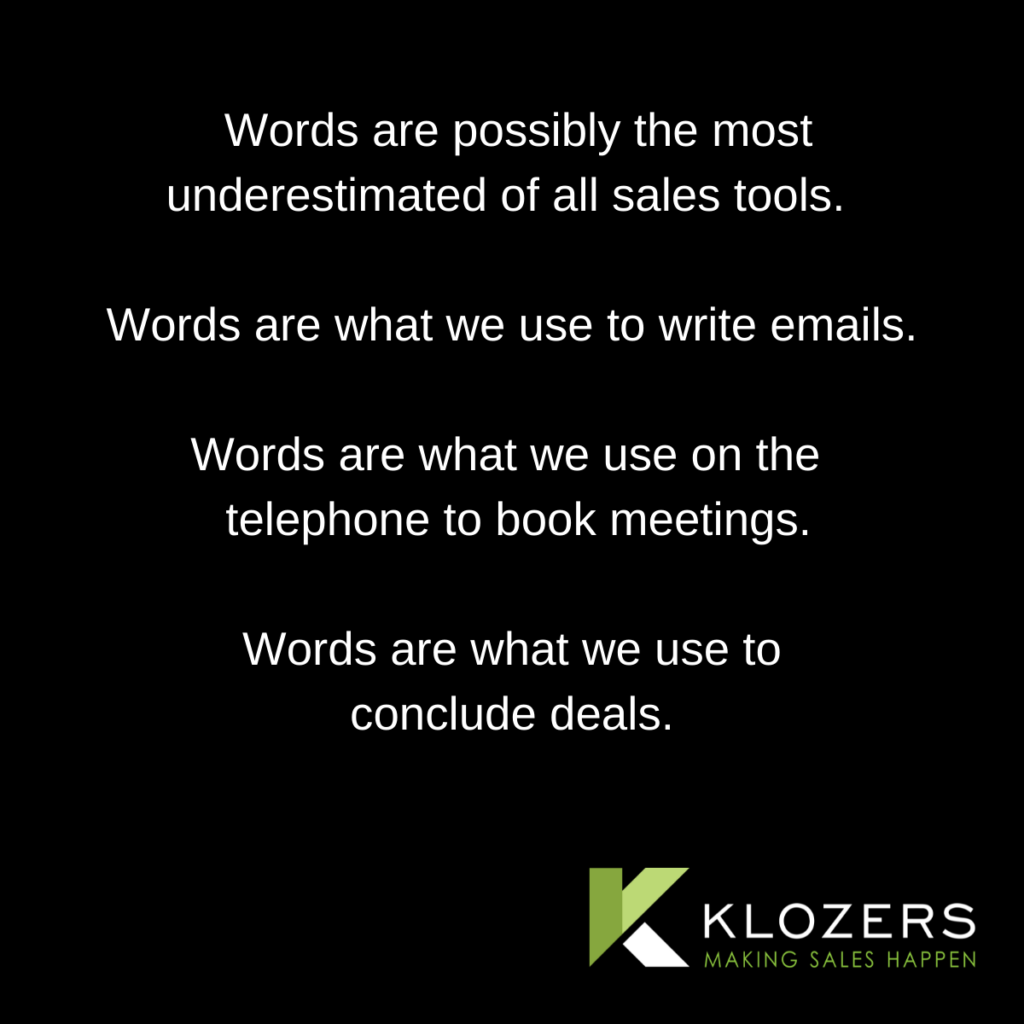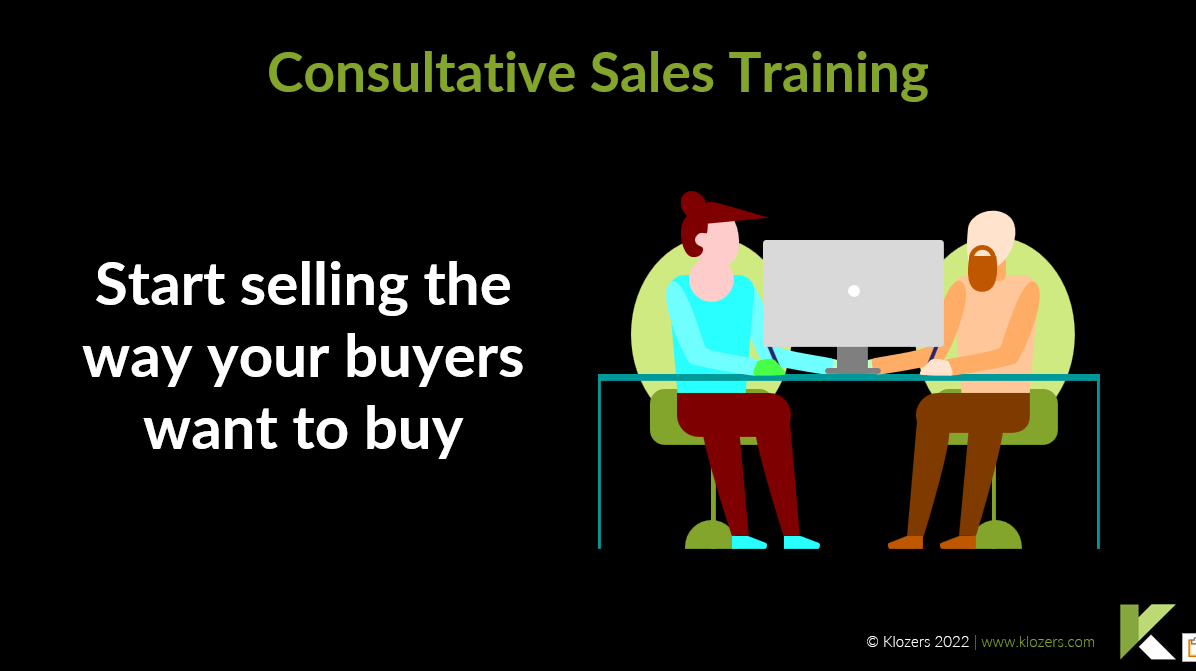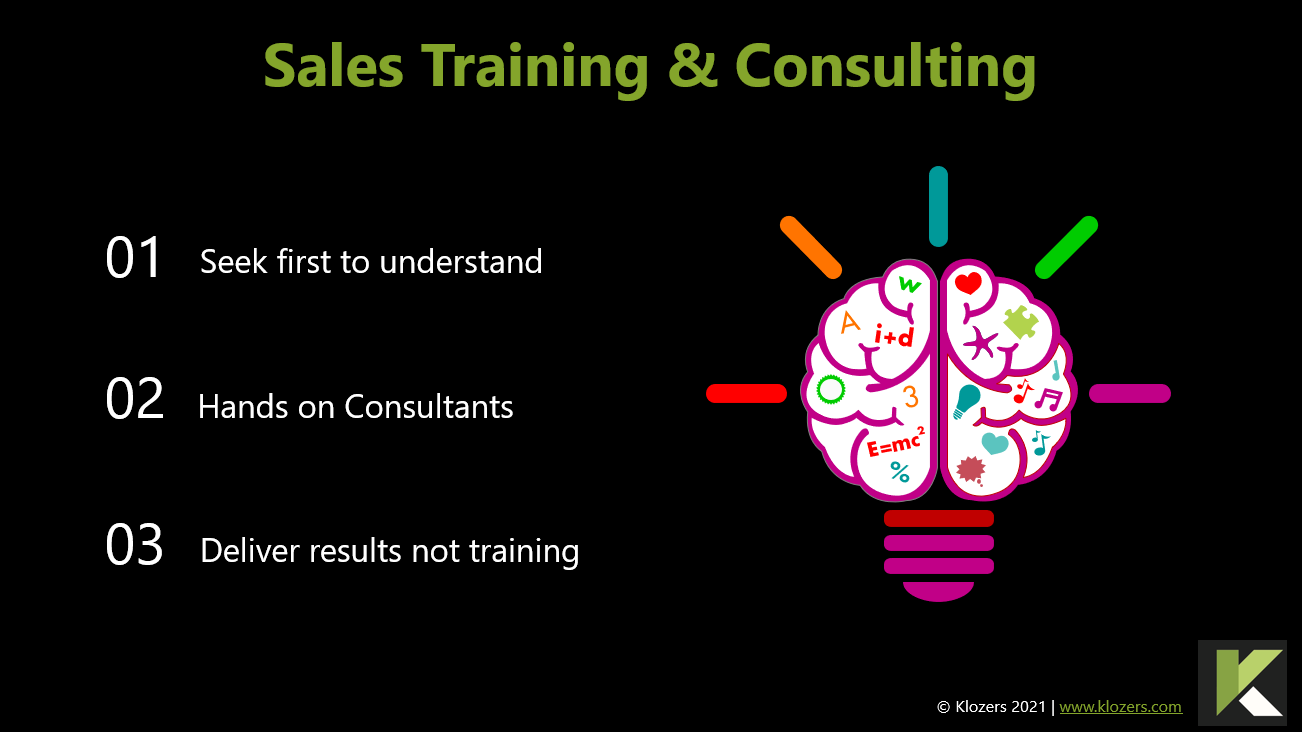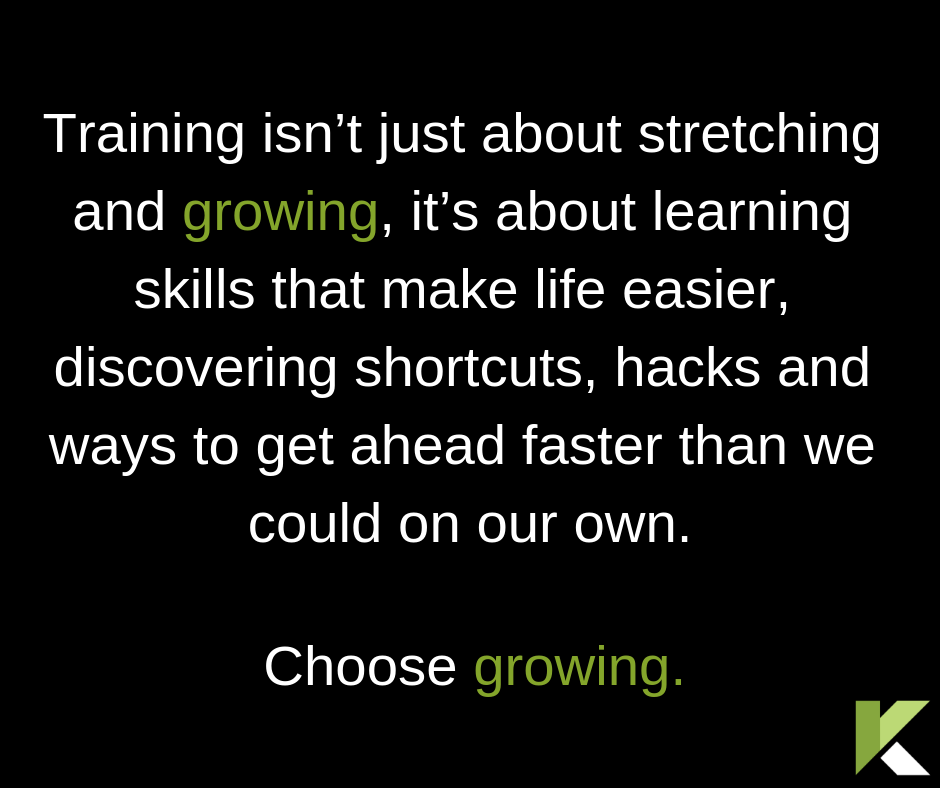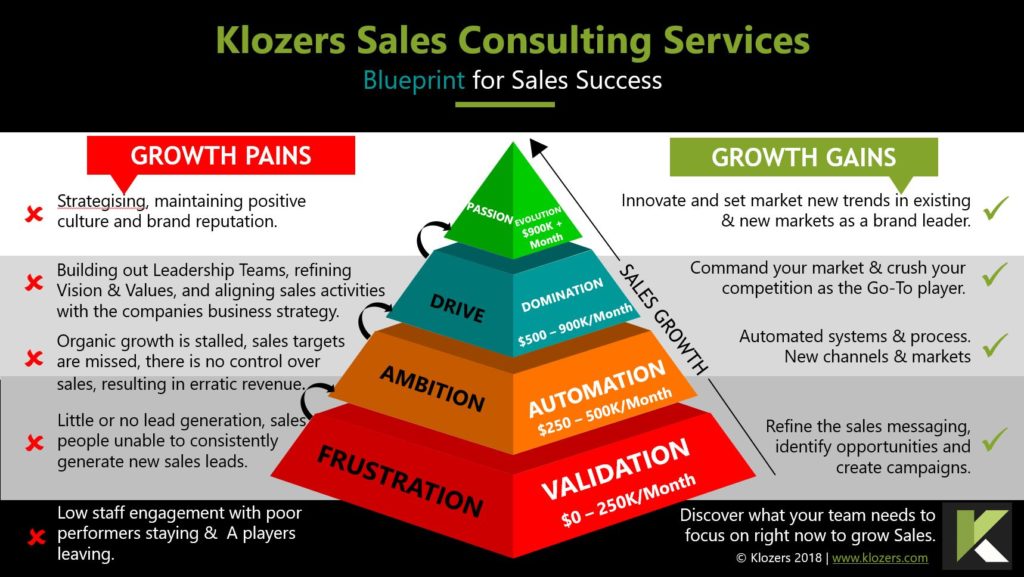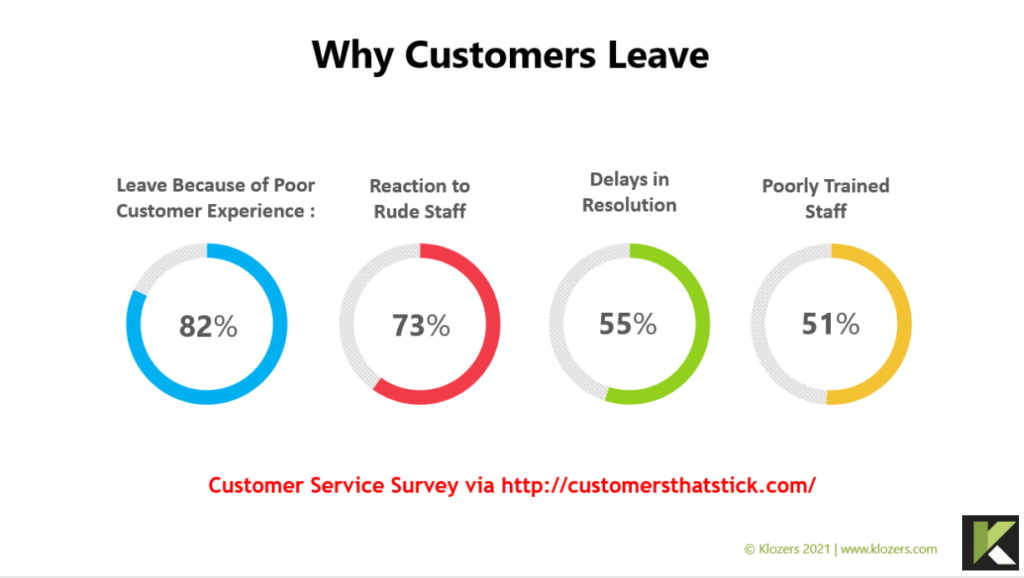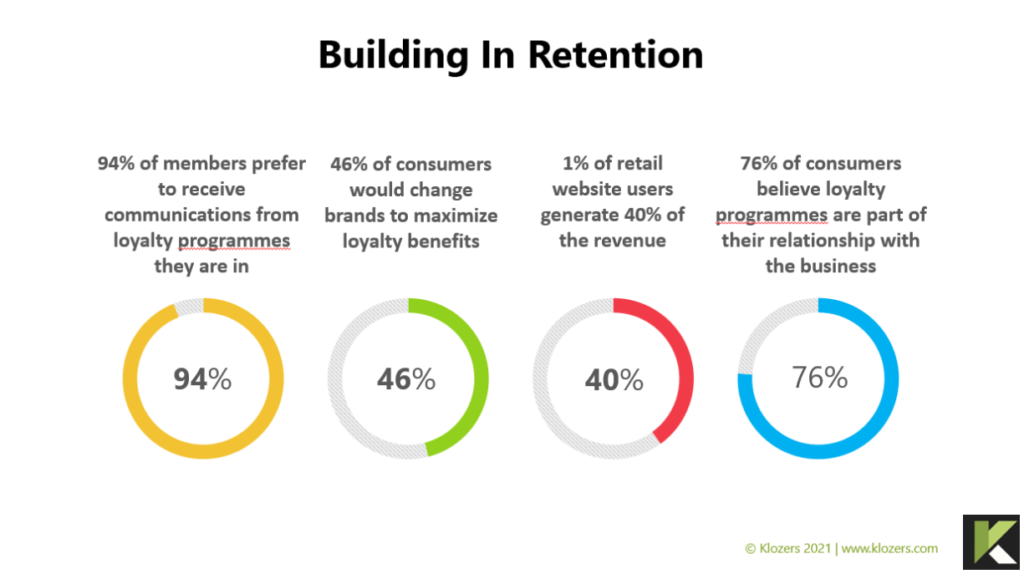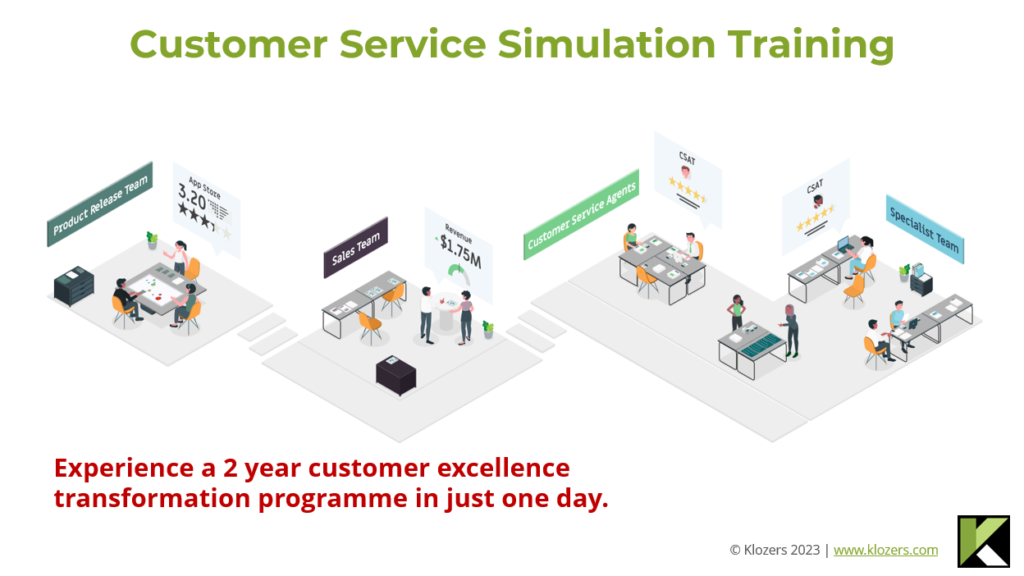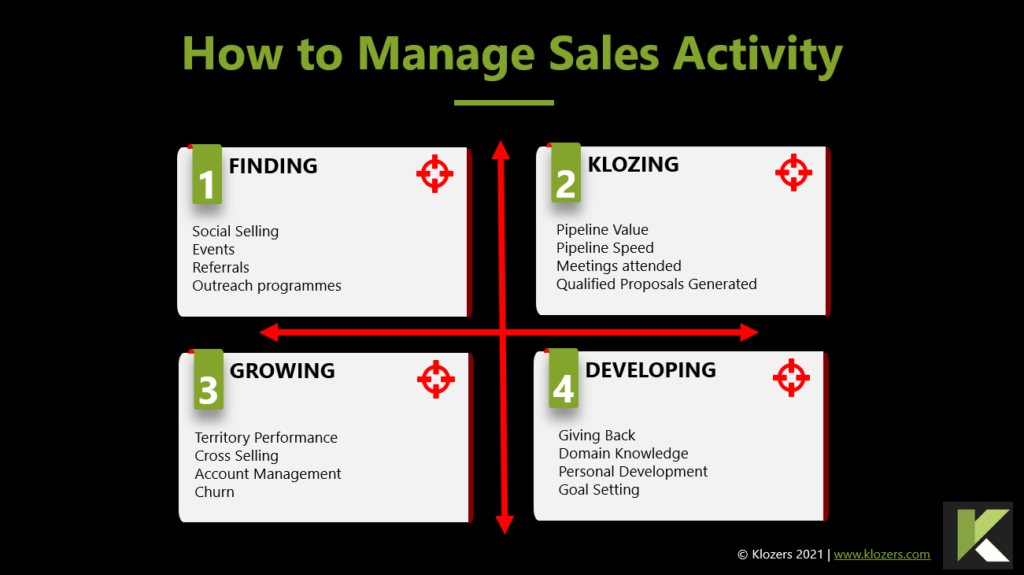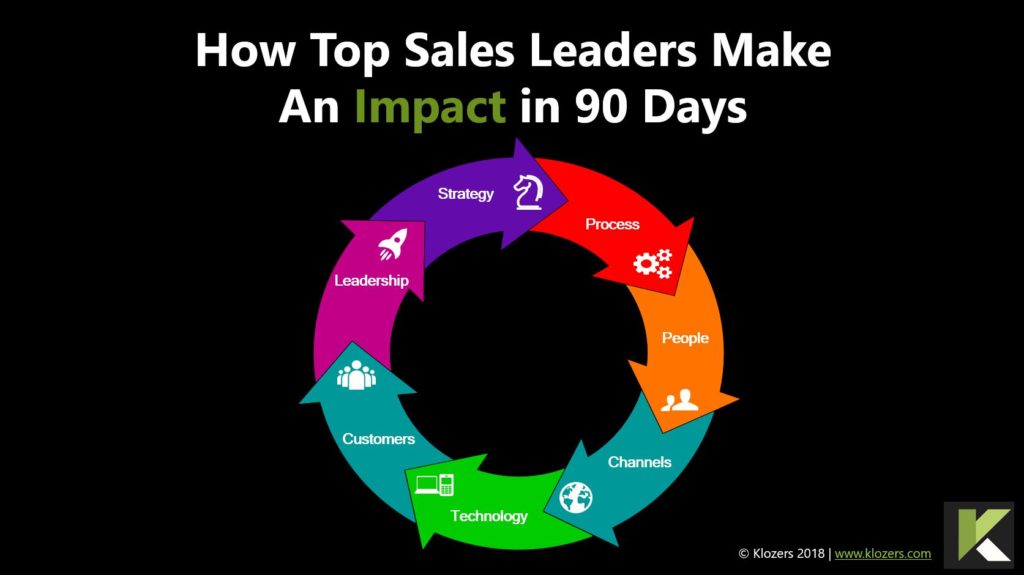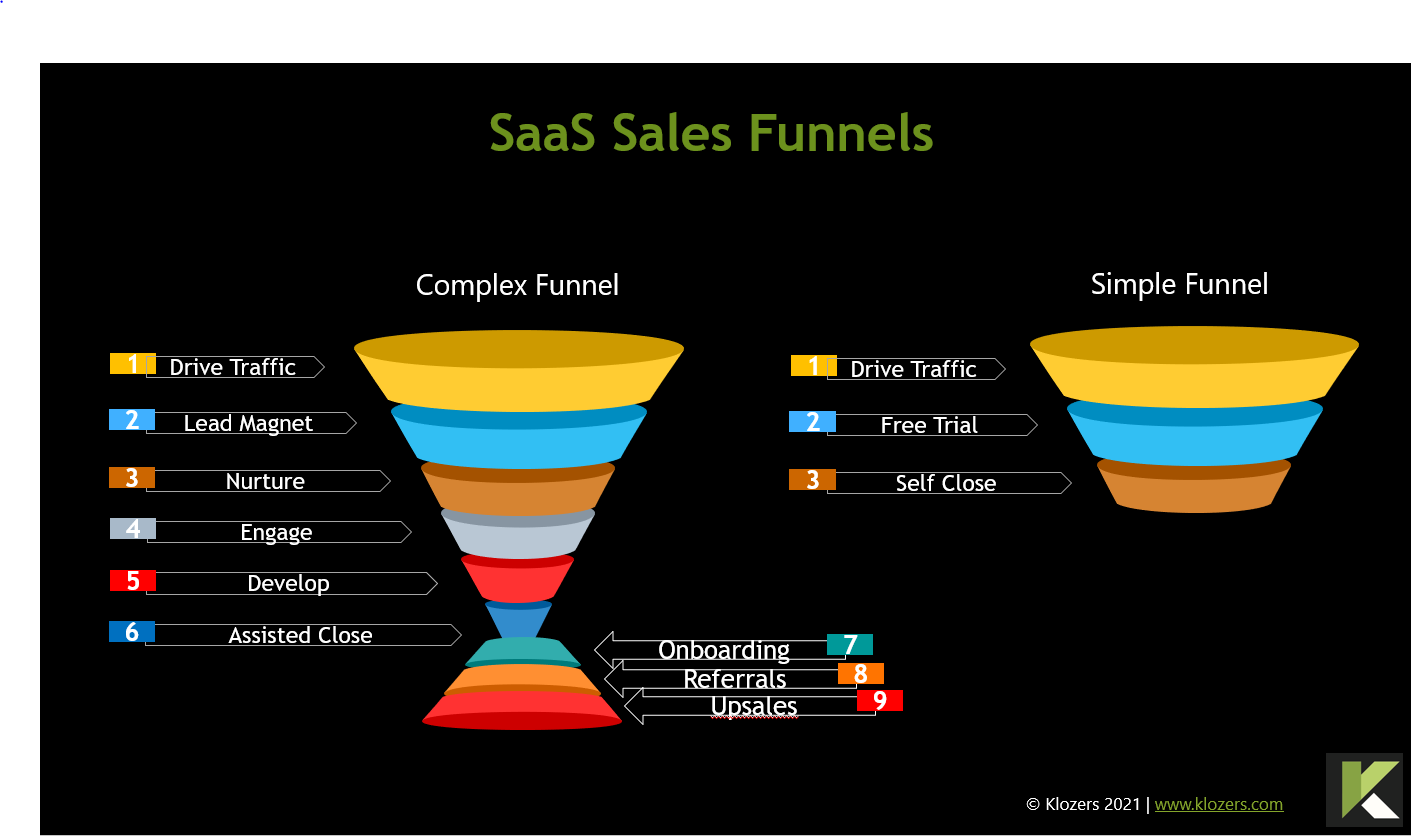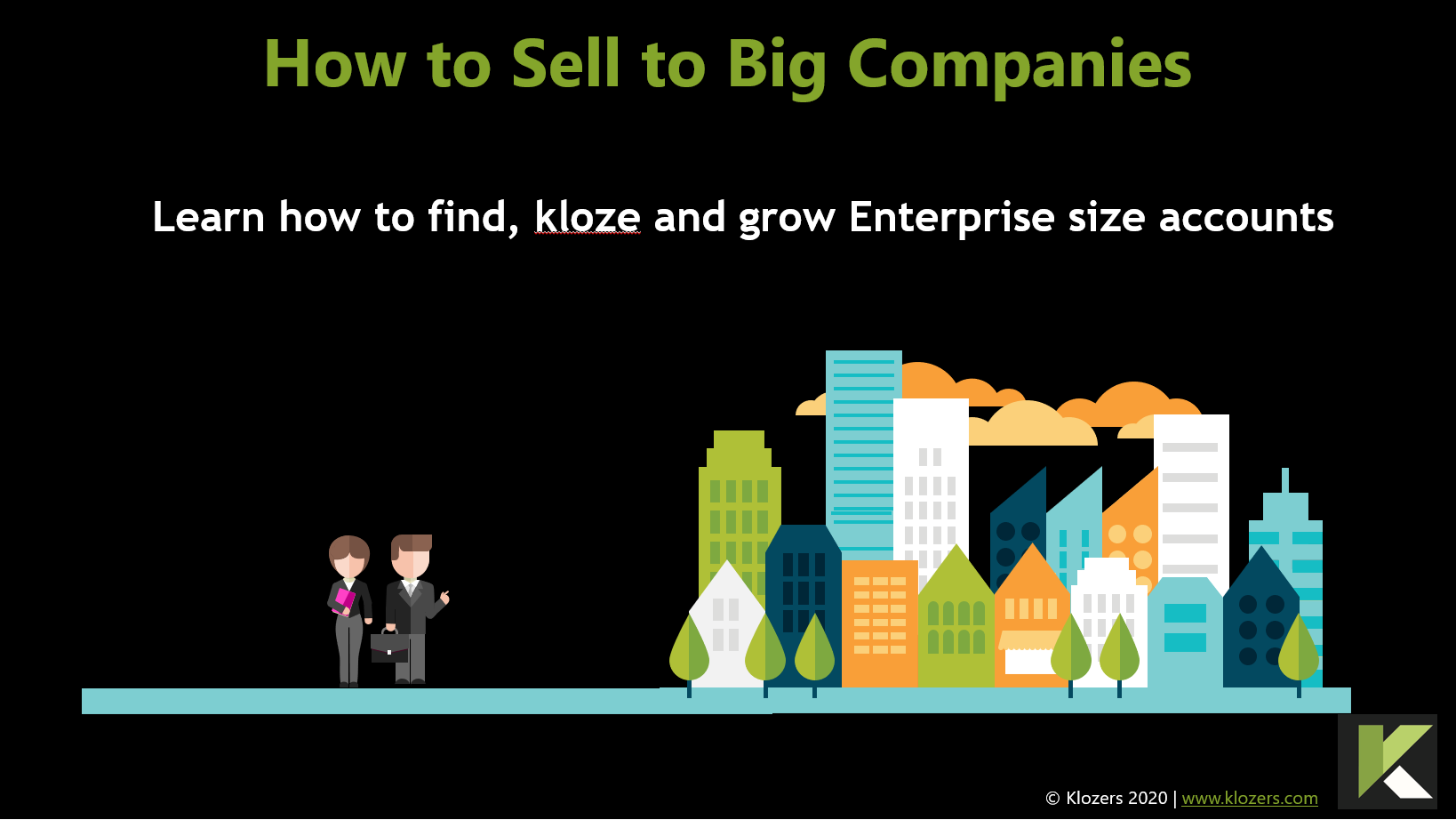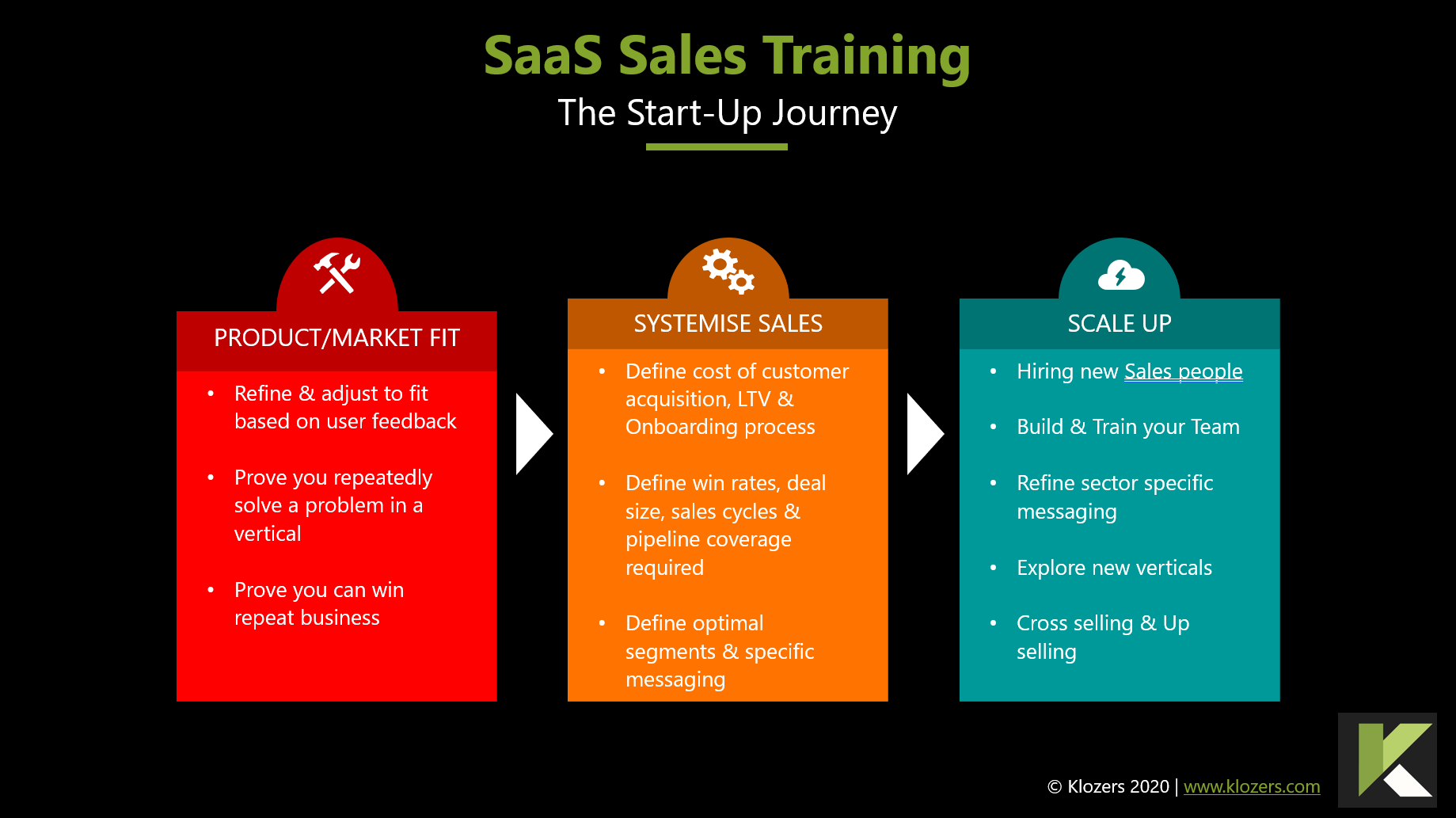Kursus Latihan Jualan
Kategori kandungan kami ini tertumpu pada kursus latihan jualan
Sales Negotiation Training
Key Negotiation Skills – Introduction
There is a common misconception that sales negotiation skills are only required towards the end of the sales process. The part in every sales process where costs and terms are agreed. Whilst this is undoubtedly true, it’s also true that the best salespeople are negotiating all the way through the sales process. In fact every Professional salesperson negotiates, every single day which is why it’s an important part of any training programme.
From negotiating with their children on what to have for breakfast, to negotiating with a Partner on where to go for dinner. In between times they will negotiate workloads with their line managers, negotiate meeting times with co-workers, negotiate dates & times for appointments with prospects and lastly negotiating sales contracts, project delivery and aftercare contracts. In short, Negotiation is actually unavoidable, and the ability to Negotiate is a core skill for every Salesperson.
Planning for Sales Negotiations
Like most things in life when it comes to Negotiation knowledge is power. The more information you have and better prepared you are then the more likely you will achieve a successful negotiation. Follow the information below to discover how to research and plan your next negotiation.
Sales Negotiation Goals
These are the needs, wants and desires of the parties involved in the negotiation. In business this can be complicated as not only may both sides have differing goals, but parties within each side may have differing and even conflicting Goals.
Goals can be subjective for example “We need to increase the confidence of our people.” or they can be more objective like “We need to reduce our overheads by 10 this quarter”. Either way it’s important to know both your own Goals and that of the other side. Important questions you must ask are:
- Have we identified all the Goals?
- What are the Prioritised Goals?
- What are the Business Goals?
- What are the Personal Goals?
- Are there conflicting Goals?
| Business Goals Examples | Personal Goals Examples |
| Strategic | Security |
| Change | Satisfaction |
| Growth | Peer Pressure |
| Improvement | Financial Gain |
Please note Goals are NOT the same as outcomes.
Example:
Goals – George is 65 years old and would like to retire (Goal). In order to fund his retirement he needs to sell his business but no one wants to invest a large sum of capital. Mike would like to buy a business (Goal) but does not have any capital to invest.
The Outcome is the Negotiated agreement that they come to.
Negotiation Options
These are all the possible solutions that satisfy the goals of both parties. They are all possibilities that both parties agree or say Yes to.
By investing time to explore all the Options then you are more likely to find:
- Alternative solutions
- Enable both parties to achieve their goals
- Reach the Best Possible Agreement (BPA)
Example:
Goals – George is 65 years old and would like to retire (Goal). In order to fund his retirement he needs to sell his business but no one wants to invest a large sum of capital. Mike would like to buy a business (Goal) but does not have any capital to invest.
Option – George can sell his business to Mike but rather than invest a lump sum he agrees to pay George on a Monthly basis from the profits for the next 5 years and hence fund his retirement.
Criteria for Negotiation
Criteria are the “terms” of any possible Option
Example:
Goals – George is 65 years old and would like to retire (Goal). In order to fund his retirement he needs to sell his business but no one wants to invest a large sum of capital. Mike would like to buy a business (Goal) but does not have any capital to invest.
Option – George can sell his business to Mike but rather than invest a lump sum he agrees to pay George on a Monthly basis from the profits for the next 5 years and hence fund his retirement.
Criteria – George needs to guarantee a minimum payment every month regardless of the profitability of that month. Mike needs to ensure ensure he will not be liable for any warranty, liability or compensations claims from the period before he take responsibility/ownership of the business.
Get expert Sales Negotiation Training from our Sales Coaches
CNA – Cost of No Agreement
Not all Negotiations end in an agreement, it is therefore vital before entering into any Negotiation that you first work out what the Cost of No Agreement is for both parties. The costs of no agreement can be both Objective and Subjective.
Example:
Goals – George is 65 years old and would like to retire (Goal). In order to fund his retirement he needs to sell his business but no one wants to invest a large sum of capital. Mike would like to buy a business (Goal) but does not have any capital to invest.
Option – George can sell his business to Mike but rather than invest a lump sum he agrees to pay George on a Monthly basis from the profits for the next 5 years and hence fund his retirement.
Criteria – George needs to guarantee a minimum payment every month regardless of the profitability of that month. Mike needs to ensure ensure he will not be liable for any warranty, liability or compensations claims from the period before he take responsibility/ownership of the business.
CNA – George does not have the financial resources to retire (Objective) however he has been trying unsuccessfully to sell his business for three years and is now desperate (Subjective) for a solution. Mike is keen to buy a business (Objective) but knows there are hundreds of businesses for sale and he is pretty relaxed (Subjective) if this deal doesn’t go through another one will come along.
The Subjective Cost of No Agreement can be more powerful than the Objective ones as people make decisions emotionally and then justify their position intellectually afterwards.
BATNA – Best Alternative to No Agreement
Not all Negotiations end in an Agreement, it is therefore vital before entering into any Negotiations that you first work out what the Best Alternative to No Agreement is. In some cases you may well experience that the other party is so entrenched in their position that they have no desire to Negotiate. BATNA is typically but not always, an alternative course of action that can be taken if no agreement is reached.
BATNA helps you prepare for a Negotiation by:
- Helps prevent you from agreeing to something you will regret
- Defining your Minimum Possible Agreement (MPA)
- Provides you with a Plan B
- Helps prevent you from over or underestimating the your own and the other party’s position
- Helps you understand where the leverage is
- Identifying alternative Options
Example:
Goals – George is 65 years old and would like to retire (Goal). In order to fund his retirement he needs to sell his business but no one wants to invest a large sum of capital. Mike would like to buy a business (Goal) but does not have any capital to invest.
Option – George can sell his business to Mike but rather than invest a lump sum he agrees to pay George on a Monthly basis from the profits for the next 5 years and hence fund his retirement.
Criteria – George needs to guarantee a minimum payment every month regardless of the profitability of that month. Mike needs to ensure ensure he will not be liable for any warranty, liability or compensations claims from the period before he take responsibility/ownership of the business.
CNA – George does not have the financial resources to retire (CNA) and has been trying unsuccessfully to sell his business for three years and is now desperate for a solution. Mike is keen to buy a business and has spent £3,000 with Solicitors and Accountants thus far completing his due diligence on the company.
BATNA – George is in discussion with his Lawyers to explore the possibilities of a Management Buyout for the business. Mike knows there are hundreds of businesses for sale and he is pretty relaxed if this deal doesn’t go through another one will come along.
Concessions for Negotiation
A concession is something given to the other party in furtherance of the agreement. These concessions should be identified in advance and segmented for both parties in terms of:
High Value – High Cost
High Value – Low Cost
Remember – Never give anything away without receiving something of equal or greater value in return.
Example:
Goals – George is 65 years old and would like to retire (Goal). In order to fund his retirement he needs to sell his business but no one wants to invest a large sum of capital. Mike would like to buy a business (Goal) but does not have any capital to invest.
Option – George can sell his business to Mike but rather than invest a lump sum he agrees to pay George on a Monthly basis from the profits for the next 5 years and hence fund his retirement.
Criteria – George needs to guarantee a minimum payment every month regardless of the profitability of that month. Mike needs to ensure ensure he will not be liable for any warranty, liability or compensations claims from the period before he take responsibility/ownership of the business.
CNA – George does not have the financial resources to retire (CNA) and has been trying unsuccessfully to sell his business for three years and is now desperate for a solution. Mike is keen to buy a business and has spent £3,000 with Solicitors and Accountants thus far completing his due diligence on the company.
BATNA – George is in discussion with his Lawyers to explore the possibilities of a Management Buyout for the business. Mike knows there are hundreds of businesses for sale and he is pretty relaxed if this deal doesn’t go through another one will come along.
Concessions – George is prepared to spend 3 months of his time ensuring during the handover period which is Low Cost to him as he will be retired but High Value to Mike as he is new to the industry and recognises the benefit of George’s experience.
Mike is prepared to move quickly which has no cost to him however this is High Value to George as the last thing he wants is a long protracted sale.
Negotiation Strategies
Aggressive Tactics
- Shoot the hostage
- This strategy is extremely aggressive as it involves an immediate offer to walk away with no deal which is designed to throw and unsettle the other party. This is often delivered in a reluctant tone “we don’t want to do this but…”,
- Delaying tactics
- When time is clearly on one parties side the process can often be deliberately slowed which is extremely effective when there are cost implications if talks over run. This tactic also applies if the other party has another meeting or needs to leave. The negotiator deliberately talks around the subject to delay the real conversation and then uses time to put pressure on the other party to come to an agreement.
- Poor Me
- This strategy is used to play the false victim that needs rescued by the other party.
- Last Minute.com
- As the name suggests this strategy involves the Negotiator agreeing to a solution right up until they are required to sign and then withdrawing. The withdrawal is usually followed up quickly with a counter offer at dramatically reduced terms.
- Misleading/lying
- Often Negotiators will make exaggerated claims or even lie so without hard data to support them you should discount these. They may also issue warnings and threats or make matters personal to unbalance you.
- Missing People
- Everyone knows the importance of having all the Decision Makers in the room but Negotiators may even turn up with complete strangers. In sales some companies will remove Sales People from the final negotiations. If the Sales People have a relationship with the other party they could be more empathetic and weaker negotiators. Turning up without warning with complete strangers also unbalances the other party.
Co-operative Tactics
- Agree on the Process
- Spend time up front agreeing the process and format of the Negotiations including what’s in scope and what’s not.
- Win Win Agreements
- Most professional Negotiators accept that any final agreement must be fair and sustainable for the life of the time period. In most business scenarios it should never be win at all costs as this destroys relationships.
- Matching Rights
- Offer the other party the right to match any solution that you receive. For example if one of two business partners decides to sell their shares to another party they may have the agreement that the other party gets first refusal if they match the offer.
- Contingent Agreements
- These are simply agreements based on future events. Financial Bonus may be tied to Performance. Football transfer fees can be include Contingent Agreements that provides the selling club additional revenue if a player is sold on and or if a player is capped by their country or simply makes a certain number of appearances.
- Multiple Offers
- When multiple offers are placed on the table this allows both parties to indicate preferences and encourages creativity as a winning hybrid offer can be formed. Placing one offer on the table often leads to a refusal and a stall in the process.
Sales Negotiation Checklist
1. Be prepared to walk away. Sales Negotiation is 70% Mindset and 30% Strategy and unless you are prepared to walk away, no strategy will help you.
2. It’s not what you charge it’s what your worth. Thoroughly research the market and discuss with the buyer the Value you bring to the table?
3. Take council from colleagues and external advisors and agree a pre-meeting strategy for the negotiations then PRACTICE.
4. Never give anything away without receiving something of equal or greater value in return.
5. Never enter a Negotiation without first providing your price and outline terms in advance, to anchor the prospect to a higher number and terms.
6. Where possible in high value deals do not include your sales people in Negotiations, as they will be emotionally involved in the sale and not objective.
7. Ensure everyone in your team have agreed in advance your trade-offs, your concessions, and your best alternative to a negotiated settlement.
8. You must be comfortable with silence and at most only talk 30% of the time, as the more you talk the more information you are giving away.
9. If it’s not Win Win then you run the danger of the prospect backing out or failing to implement your agreement, then the lawyers are the only winners.
10. Negotiation is between human beings, you must therefore be familiar with Human Psychology, DiSC, Neuro Linguistic and Programming.
Cara Membina Corong Jualan SaaS
1. Apakah itu Corong Jualan?
Corong jualan ialah urutan tindakan, peristiwa atau peringkat yang dilalui pengguna sebelum membeli produk atau perkhidmatan. Corong jualan direka bentuk untuk membolehkan pemasar menjejak, merekod dan mengoptimumkan proses jualan untuk meningkatkan hasil.
Anda boleh mengetahui lebih lanjut tentang latihan jualan SaaS kami di sini .
2. Bagaimana untuk membina Corong Jualan SaaS
Corong jualan SaaS anda ialah bahagian penting dalam kejayaan Apl anda. Jika anda menawarkan apl SaaS maka mencipta corong jualan yang boleh berulang, berskala dan boleh dijejaki ialah salah satu langkah penting yang perlu anda ambil.
Kedengaran mudah? Kemudian fikir semula. Corong jualan adalah tempat banyak syarikat baru beralih ke perjuangan menjana pendapatan, dan dalam banyak kes gagal.
Sebelum mula membina corong anda adalah wajar mempertimbangkan di mana anda berada dalam perjalanan apl anda.
3. Tiga peringkat utama pembangunan SaaS
Malangnya, dalam jualan tidak pernah ada penyelesaian satu saiz yang sesuai untuk semua, dan titik permulaan untuk membina corong jualan SaaS bergantung pada tempat anda berada, dari segi tiga peringkat utama perniagaan SaaS?
Adakah anda di:
Fasa 1 : permulaan perjalanan di mana Pengasas dan pasukan utama masih cuba untuk mewujudkan kesesuaian produk/pasaran.
Fasa 2 : di mana pengasas dan ahli pasukan utama telah membuktikan kesesuaian produk/pasaran dan membuktikan mereka boleh melaksanakan sistem dan proses yang boleh digunakan oleh orang lain untuk menjual.
Fasa 3 , halangan terakhir di mana anda mempunyai kesesuaian pasaran produk yang terbukti, anda telah mengenal pasti dan membuktikan sistem dan proses yang betul untuk penskalaan dan anda kini bersedia untuk meningkatkan jualan anda, menumpukan pada pemerolehan pelanggan dan membina MRR anda.
Strategi yang anda gunakan untuk membina corong jualan SaaS akan berbeza-beza bergantung pada perkara yang anda pelajari dalam Langkah 1 di atas.
Jadi untuk tujuan latihan ini saya akan menganggap anda berada di Langkah 1. Jika anda masih bergelut untuk membina corong jualan pada langkah 2 dan 3 maka sama ada anda terlepas sesuatu pada langkah 1 atau sesuatu telah berubah yang menyebabkan semua yang anda pelajari pada langkah 1 berhenti berfungsi.
4. Bina corong pemasaran sebelum corong jualan anda
Dengan mana-mana perniagaan adalah penting untuk anda menyediakan keadaan optimum untuk pasukan jualan anda berjaya. Dalam dunia SaaS tidak mencukupi untuk mempunyai tapak web yang hebat, anda memerlukan tapak web yang:
a) boleh didapati oleh produk dan perkhidmatan anda dalam enjin carian utama – Google, Bing, Yahoo & YouTube
b) boleh didapati dengan masalah yang anda selesaikan dalam enjin carian utama – Google, Bing, Yahoo & YouTube
c) boleh menukar trafik web kepada pemasaran petunjuk yang layak
Banyak syarikat mengabaikan perkara ini dan tergesa-gesa membina pasukan jualan keluar. Hakikatnya ialah setiap prospek berpotensi yang diminati oleh Pasukan keluar anda akan pergi ke tapak web anda untuk membuat penyelidikan lanjut.
Melainkan pengalaman web adalah sama atau lebih besar daripada pengalaman prospek dengan pasukan keluar anda, mereka akan segera dimatikan.
Untuk membina corong pemasaran anda mesti mencipta “kandungan pertama pengguna yang menarik”. Ini adalah kandungan yang sedang dicari oleh pengguna secara aktif bukan kandungan yang ingin didorong oleh pasukan jualan dan pemasaran anda.
Corong pemasaran SaaS anda ialah bahagian penting dalam strategi jualan Masuk anda. Untuk melakukan ini dengan jayanya, anda perlu mencipta kandungan berkualiti tinggi pada setiap peringkat perjalanan pembeli seperti yang ditunjukkan di bawah.
Kandungan harus menceritakan kisah jenama anda secara halus dan kejayaan yang telah anda bawa kepada pengguna lain. Jadikan pengguna awal anda sebagai Pahlawan bukan anda.
TOFU – Bahagian atas corong
Bahagian pertama corong jualan anda atau dikenali sebagai TOFU ialah peringkat kesedaran corong tersebut. Prospek menyedari masalah yang mereka hadapi dan sedang menyiasat penyelesaiannya.
Tapak web anda mesti mempunyai kandungan yang membincangkan masalah ini dan meletakkan syarikat anda sebagai Pakar Perkara . Kandungan yang paling popular di sini ialah:
Bagaimana untuk membimbing
Video penerangan
Catatan blog
Magnet Plumbum
Pada peringkat ini, prospek berada dalam mod penyelidikan, bukan mod membeli dan hanya mengumpul maklumat.
Prospek anda mungkin tidak berminat dengan penyelesaian pada peringkat ini kerana mereka masih cuba untuk mendiagnosis sendiri masalah mereka sendiri dengan tepat. Tidak mungkin prospek anda ingin bercakap dengan jualan pada peringkat ini.
Kami mengesyorkan anda menggunakan automasi pemasaran untuk menjejak artikel/halaman mana prospek anda memasuki tapak kerana ini adalah masalah yang menjadi perhatian utama mereka. Mengetahui perkara ini boleh memudahkan jualan untuk mengadakan perbualan yang berkaitan dengan mereka.
Anda juga mungkin berjaya melibatkan prospek dengan chatbots di tapak anda, namun ramai yang mahu kekal tanpa nama pada peringkat ini.
Tengah Corong
Pertengahan corong jualan anda ialah apabila prospek mula menilai penyelesaian khusus berdasarkan apa yang mereka pelajari pada peringkat 1. Bahagian tengah kandungan corong termasuk:
Persembahan
Demonstrasi
Kajian kes
Dari segi praktikal, mereka akan membuat beberapa bentuk senarai pendek pembekal yang berpotensi, dan mereka kemudiannya akan menggali lebih dalam butiran setiap penyelesaian yang berpotensi.
Pada peringkat ini prospek mungkin masih tidak terlibat dengan anda kerana mereka selalunya hanya menyelidik bagi pihak orang lain dalam organisasi mereka sendiri dan keutamaan mereka adalah pengumpulan maklumat.
Bahagian bawah Corong
Pada masa prospek anda telah mencapai bahagian bawah corong pemasaran anda dalam banyak kes mereka telah “membeli” satu pembekal atau penyelesaian tertentu.
Mereka telah membuat keputusan sebahagian besarnya mengenai pengalaman web mereka tentang jenama, pemesejan jualan anda dan keupayaan anda untuk meletakkan diri anda bukan sahaja sebagai pemimpin walaupun tetapi sebagai pemimpin pemikiran yang memahami masalah mereka.
Bahagian bawah kandungan Corong akan termasuk perkara seperti:
penetapan harga
Jadual perbandingan
Testimoni
Ulasan
Untuk penyelesaian yang lebih mudah dengan harga lebih rendah, anda akan mendapati mereka kini bersedia untuk mengambil percubaan jika anda menawarkan Seruan Tindakan (CTA) yang kukuh, manakala untuk penyelesaian yang lebih mahal dan kompleks, mereka kini akan terlibat dengan jualan.
Imej di bawah menunjukkan di mana corong pemasaran mudah beralih ke troli beli-belah dan jualan B2B yang lebih kompleks beralih kepada petunjuk untuk jualan.
Kejayaan bukan terletak pada memilih model yang betul, tetapi membina model anda sendiri berdasarkan data dan percubaan dan kesilapan.
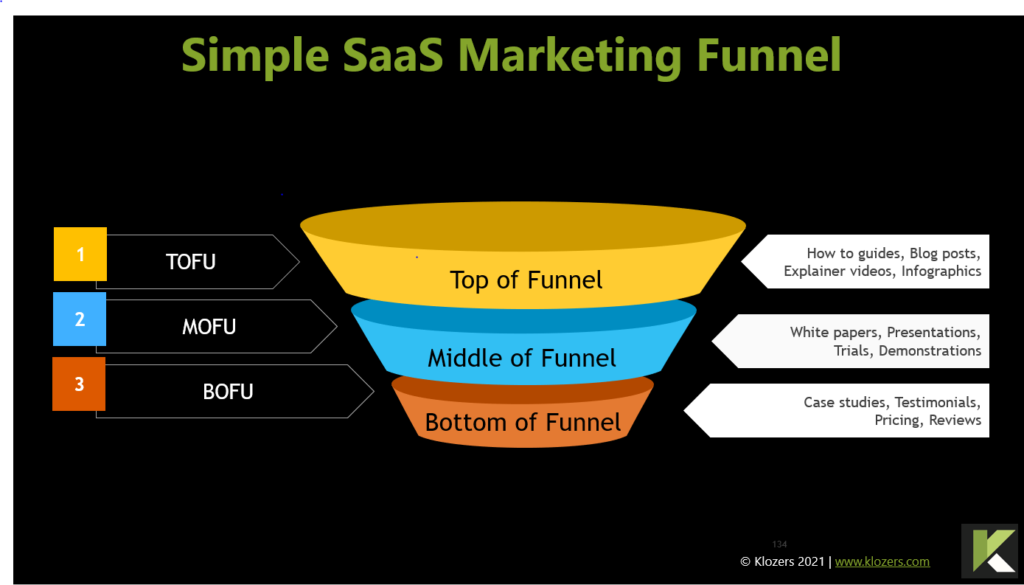
Kebanyakan perisian pemasaran kini menjejaki tingkah laku pengguna di tapak web anda dan mungkin menggunakan pemarkahan petunjuk untuk memaklumkan jurujual apabila masa terbaik untuk mendekati prospek secara proaktif.
Dari pengalaman kami sendiri, masanya hampir selalu kepada awal dan program pemupukan utama yang jelas adalah sama berkesan.
Untuk melakukan ini, anda harus membina dalam pemasaran anda sekurang-kurangnya tiga magnet utama berbeza yang akan membantu anda menjadikan pelawat web anda menjadi pelanggan supaya anda boleh terus berhubung.
5. Pengiklanan untuk mengisi Corong Jualan anda
Banyak syarikat berjaya mengisi corong jualan mereka melalui pengiklanan. Pengiklanan digital telah matang ke tahap yang membolehkan penjejakan dan pelaporan yang ketara membolehkan anda memahami Nisbah Penukaran dan CAC anda dalam masa beberapa minggu.
Pada peringkat pertama, kami akan menyokong “Kempen Penyasaran Semula”. Ini hanyalah proses meletakkan tambahan di hadapan orang yang telah melawat tapak web anda.
Kajian menunjukkan penyasaran semula adalah tujuh kali lebih berkesan daripada kempen baharu, itulah sebabnya kami menganjurkan ini sebagai titik permulaan.
Strategi ini berfungsi dengan sangat baik dengan kempen pemasaran kandungan yang kuat. Saluran tambah yang paling popular untuk B2B ialah LinkedIn, namun, banyak syarikat juga telah berjaya dengan Facebook dan Instagram.
Tidak perlu dikatakan ini akan ditakrifkan oleh khalayak anda. Pengiklanan boleh digunakan dalam corong mudah untuk memacu jualan dan yang lebih kompleks untuk mendorong pertanyaan baharu untuk wakil jualan.
Jualan yang lebih kompleks mungkin memerlukan urutan yang ditentukan di mana pengguna mengklik dan mengiklankan untuk menerima magnet petunjuk dengan setiap petunjuk berharga $3.
Jika anda kemudiannya berjaya menukar 5% daripada petunjuk baharu ini, anda boleh mengaitkan $60 setiap jualan daripada pengiklanan kepada CAC anda.
Anda boleh membina urutan atau model yang boleh dijejaki daripada sebarang aktiviti bukan sahaja pengiklanan. Contohnya, acara, webinar dan telejualan membolehkan anda memahami aktiviti mana yang paling berkesan kos bukan sahaja untuk mengisi corong anda, tetapi sebenarnya menukar kepada pesanan.
6. Cara Membina Corong Jualan SaaS
Corong jualan anda akan berbeza-beza bergantung pada strategi jualan anda. Adakah anda menjual Apl anda secara langsung atau adakah anda menjual melalui rakan kongsi? Saluran manakah yang telah anda putuskan untuk fokus pada mulanya?
1. Kenal pasti Profil Prospek Sempurna anda. Ini ialah versi wakil jualan persona pemasaran. Ia termasuk semua yang akan disertakan oleh persona pemasaran, serta beberapa maklumat tambahan yang membantu jualan memahami dan berkomunikasi pada tahap yang lebih mendalam dengan prospek.
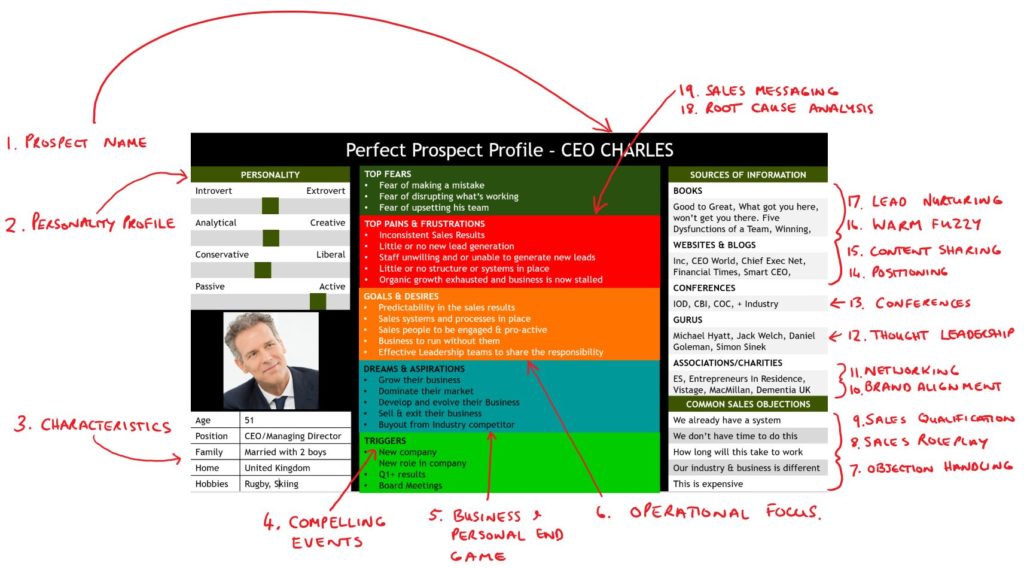
2. Bina pemesejan jualan anda. Sebahagian daripada kesesuaian produk/pasaran ialah memahami masalah perniagaan dan atau peribadi yang diselesaikan oleh produk anda.
Dalam pengalaman kami perkhidmatan SaaS yang paling berjaya ialah penyelesaian perniagaan yang menyelesaikan masalah perniagaan.
Sebaik sahaja anda memahami bagaimana ini berkaitan dengan produk/perkhidmatan anda sendiri pada tahap yang mendalam, anda boleh mula membina pemesejan jualan anda.
Ini adalah perkataan dan bahasa bernuansa yang telah anda buktikan bahawa prospek berhubung dengannya. Tidak cukup mengetahui tentang perniagaan dan penyelesaian anda sendiri, anda harus tahu tentang pelanggan anda.
Anda harus tahu dengan tepat bagaimana penyelesaian anda membantu pelanggan anda menjimatkan wang, menjana wang dan menjadikan kehidupan mereka lebih mudah.
3. Kempen Penjanaan Utama.
Sebaik sahaja anda telah mengenal pasti prospek sasaran anda dan membina pemesejan jualan anda, anda perlu mula bekerja pada kempen Penjanaan Utama.
Terdapat dua pendekatan utama untuk Penjanaan Peneraju seperti berikut:
a) Penjanaan Peneraju Masuk. Kempen penjanaan petunjuk masuk ialah tempat prospek menghubungi anda terlebih dahulu. Mereka boleh mengisi borang di halaman web anda, menelefon anda atau menghantar e-mel kepada anda. Untuk menjana petunjuk jualan masuk, anda perlu melakukan beberapa bentuk penciptaan kandungan, kempen iklan, webinar, program rujukan atau SEO.
b) Penjanaan petunjuk keluar. Kempen penjanaan petunjuk keluar ialah tempat anda menghubungi prospek melalui telefon, e-mel, mel terus, acara atau pemasaran berasaskan akaun. Kempen keluar selalu bermakna anda perlu membina pasukan kata keluar yang mungkin mahal.
Majoriti syarikat SaaS menggunakan gabungan masuk dan keluar, walau bagaimanapun, mereka hampir selalu memberi penekanan pada satu lebih daripada yang lain.
Sebagai panduan yang sangat kasar, perkhidmatan SaaS yang berkos lebih rendah dan menyasarkan PKS adalah diterajui pemasaran dan mempunyai tumpuan utama Masuk.
Perkhidmatan SaaS yang lebih berbelanja dan menyasarkan Pasaran Pertengahan kepada organisasi Perusahaan akan mempunyai pendekatan yang lebih diterajui jualan melalui Pemasaran Berasaskan Akaun.
7. Apakah Peringkat Corong Jualan SaaS?

Peringkat corong jualan anda hanyalah satu siri langkah yang dilalui oleh prospek anda untuk membuat pesanan.
Peringkat ini boleh berbeza-beza dan tiada satu corong yang boleh anda gunakan pada setiap apl. Walaupun peringkatnya sama, kaedah yang anda gunakan untuk memindahkan prospek melalui corong mungkin berbeza-beza.
Corong jualan anda ialah tempat yang bagus untuk mula mengumpul data untuk mengukur prestasi dan membuat penambahbaikan dari semasa ke semasa.
Secara umum, prospek harus bergerak melalui corong jualan secepat mungkin – ini dipanggil kitaran jualan atau kelajuan paip.
Mengukur kelajuan prospek bergerak melalui kitaran membolehkan anda mengenal pasti sekatan dalam corong anda dan kawasan di mana prospek perlahan.
Titik “melekat” ini adalah tempat anda harus melihat untuk membuat penambahbaikan.
8. Bilakah saya boleh menunjukkan produk SaaS saya kepada pelanggan?
Masa demo aplikasi SaaS dalam proses jualan telah menjadi subjek perbincangan bagi banyak syarikat.
Jawapan malangnya kepada soalan itu ialah “terpulang”. Banyak syarikat berjaya mendemonstrasikan apl mereka pada permulaan proses jualan, walau bagaimanapun, terdapat juga ramai yang membuat demo pada permulaan dan kemudiannya prospek mereka hilang ke dalam lubang hitam mel suara dan e-mel yang tidak dijawab.
Pendek kata, penyelesaian yang lebih murah dan mudah, maka lebih awal dalam proses anda boleh demo dan penyelesaian yang lebih mahal dan kompleks demo harus ditolak sejauh mungkin dalam proses penjualan.
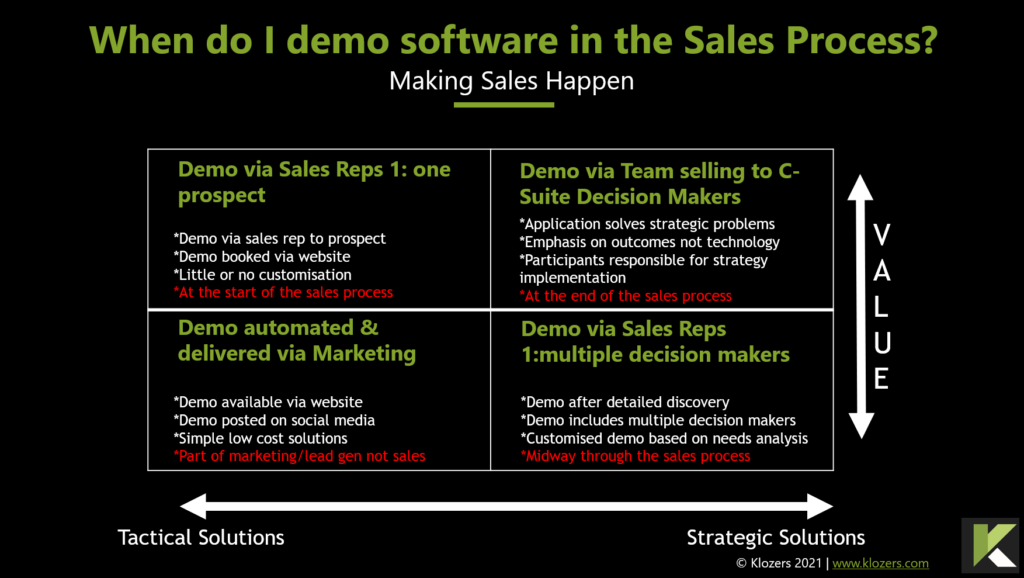
Realitinya ialah terdapat kecenderungan untuk Usahawan dan jurujual tergesa-gesa untuk mendemonstrasikan aplikasi mereka, dengan harapan demo itu akan meyakinkan prospek untuk mendaftar.
Walaupun prospek itu layak dan sesuai, demo tanpa sebarang bentuk diagnosis kesakitan prospek berada dalam bahaya kehilangan prospek.
Prospek anda perlu tahu bahawa anda tahu dan anda memahami dunia mereka. Ini hanya boleh dicapai melalui penyoalan yang bijak dan disasarkan. Jika anda ingin mempercepatkan jualan, perlahankan jualan.
Demo biasanya merupakan titik leveraj terbesar jurujual dan jika anda memberikannya tidak lama lagi anda akan kehilangan leveraj dan kemungkinan besar prospek.
Sebagai peraturan umum – tolak demo apl sejauh mungkin dalam proses jualan anda.
Demo memerlukan masa dan wang terutamanya untuk jualan yang kompleks di mana lebih kerap daripada tidak demo yang dipesan lebih dahulu diperlukan.
Sebarang demo yang dipesan lebih dahulu mesti dihantar hanya kepada pembuat keputusan kanan pada pasukan pembeli prospek. Jika sesuai, anda juga boleh mempunyai dua demo dalam proses jualan – tidak ada peraturan selain jika ia berfungsi lakukannya.
Kebanyakan wakil jualan membuat kesilapan menggunakan bahagian proses jualan ini untuk menerangkan manfaat produk dengan lebih terperinci.
Apabila anda memberitahu anda tidak menjual. Gunakan soalan penyiasatan yang bijak untuk mendapatkan prospek memberitahu anda bagaimana penyelesaian itu akan menyelesaikan masalah perniagaan mereka.
Anda harus mengelak daripada bercakap tentang ciri yang anda percaya berkaitan dengannya. Jika anda tidak mendedahkan perkara ini dalam peringkat penemuan proses jualan, sememangnya berisiko untuk memperkenalkan apa-apa yang baharu di bawah proses tersebut.
Untuk penyelesaian yang lebih mudah dengan harga yang lebih rendah, anda akan mendapati mereka kini bersedia untuk menjalani percubaan, manakala untuk penyelesaian yang lebih mahal dan kompleks, mereka kini akan terlibat dengan wakil jualan.
Untuk menunjukkan bahawa mereka telah menjalankan usaha wajar mereka akan sentiasa bercakap dengan dua atau tiga pembekal yang berpotensi.
Ini tidak semestinya untuk mengurangkan harga pembekal, tetapi kadangkala mereka perlu mengesahkan kepada kumpulan pembelian yang lebih luas dalam organisasi mereka mengapa mereka mempunyai keutamaan.
Percubaan apl juga merupakan cara yang baik untuk membuat pengguna mendaftar, namun, nisbah penukaran percubaan untuk ditutup biasanya lemah dalam kebanyakan kes SaaS.
Bergantung pada harga, anda boleh menawarkan percubaan terurus, supaya mereka boleh menilai perisian anda semasa anda mengurusnya lebih jauh di bawah proses jualan.
Semasa percubaan, prospek dapat melihat bagaimana produk akan berfungsi untuk mereka dalam amalan. Adalah penting untuk menentukan masa percubaan dengan bijak dan memastikan anda telah bersetuju terlebih dahulu apa yang berlaku jika percubaan itu berjaya.
Kami telah mencipta grafik di atas untuk cuba menerangkan secara visual cara ini mungkin berfungsi untuk organisasi anda.
Perlu diperhatikan dalam contoh, majoriti CAC anda akan menjadi pemasaran, manakala dalam corong yang lebih kompleks kos anda akan termasuk pemasaran, jualan + penerimaan pelanggan.
9. Contoh Corong Jualan SaaS
Corong jualan di bawah adalah contoh. Anda TIDAK seharusnya meniru ini melainkan ia sesuai dengan proses jualan anda.
Mereka direka bentuk untuk menjadi titik permulaan bagi mereka yang ingin membangunkan corong jualan.
Seperti yang anda lihat daripada grafik, terdapat banyak alternatif kepada peringkat yang digunakan untuk membentuk corong jualan anda bergantung pada jenis corong yang anda cipta.
Untuk corong digital semata-mata anda boleh mempunyai:
Lead Magnet Landing page – tempat prospek tiba selepas mengklik pada iklan anda
Halaman Pengesahan – mengesahkan tawaran, percubaan atau pembelian percuma anda
Halaman Upsell – di mana prospek mempunyai peluang untuk menambah perkhidmatan tambahan atau menaik taraf
Halaman pembayaran – tempat prospek membayar untuk perkhidmatan tersebut
Halaman Tahniah atau Terima Kasih – di mana anda boleh menandatangani prospek pos dengan langkah seterusnya yang sesuai.

10. Metrik corong jualan SaaS
Mengenai metrik, kami percaya ini ialah metrik dan KPI operasi jualan biasa yang biasa digunakan oleh kebanyakan orang. Tidak perlu dikatakan metrik ini penting dan anda harus merekod dan melaporkannya.
LTT – Membawa kepada penukaran percubaan
Ini ialah bilangan petunjuk yang telah menukar kepada percubaan.
DCR – Nisbah penukaran demo
Bilangan demo yang berjaya menukar ke peringkat seterusnya dalam proses jualan.
TTS – Penukaran percubaan kepada jualan
Ini ialah bilangan prospek pada percubaan percuma yang telah menukar kepada pelanggan berbayar.
LTV – Nilai Sepanjang Hayat pelanggan
Ini ialah purata jumlah nilai yang akan dibelanjakan oleh pelanggan sebelum meninggalkan perkhidmatan. Ironinya ini boleh menjadi lebih sukar untuk mengukur lebih baik produk anda kerana, tanpa pelanggan meninggalkan anda tidak akan tahu berapa lama mereka tinggal dan jumlah nilai mereka kepada perniagaan.
Churn – Bilangan pelanggan yang pergi
Pelanggan akan pergi dan itu tidak selalu menjadi perkara yang buruk. Jika pelanggan yang keluar sesuai dengan ICP (Profil Pelanggan Ideal) anda maka anda menghadapi masalah. Pelanggan yang meninggalkan yang tidak sesuai dengan ICP anda mungkin membebaskan sumber berharga yang boleh dibelanjakan untuk ICP anda.
MRR – Pendapatan berulang bulanan
Hasil berulang bulanan memberi anda gambaran keseluruhan kejayaan anda, namun, ia hanyalah gambaran keseluruhan dan anda perlu melihat butiran dalam data untuk mendapatkan gambaran yang lebih tepat.
ARR – Hasil berulang tahunan
Hasil berulang tahunan memberikan gambaran keseluruhan perniagaan yang baik, tetapi seperti MRR, anda harus mengkaji semua data untuk mendapatkan gambaran yang lebih tepat tentang kesihatan usaha niaga anda.
Kitaran Jualan – Masa dari hubungan awal hingga pesanan tertutup
Ini biasanya singkatan untuk penyelesaian yang lebih mudah bernilai rendah dan lebih lama untuk jualan Perusahaan yang kompleks. Contohnya, jualan kepada bank Tahap 1 mungkin mengambil masa 18 bulan dari hubungan awal hingga ditutup.
CAC – Kos Pemerolehan Pelanggan
Adalah penting untuk memahami kos anda untuk memperoleh seorang pelanggan. Dalam dunia yang ideal, anda akan menemui perkara ini dalam fasa awal perniagaan apabila anda membuktikan cadangan nilai. Tanpa angka ini adalah mustahil untuk dimasukkan ke dalam sistem dan proses untuk meningkatkan perniagaan kerana anda tidak akan tahu berapa banyak yang boleh anda belanjakan untuk pemasaran dan jualan bahagian hadapan.
Churn Negatif –
Pergolakan negatif ialah metrik pertumbuhan yang berkuasa yang menunjukkan bahawa hasil daripada jualan tinggi dan jualan silang pelanggan sedia ada menghilangkan hasil yang hilang apabila pelanggan pergi.
11. Penyerahan Cadangan SaaS
Selepas demo terakhir, anda tidak boleh menawarkan untuk menghantar cadangan.
Cadangan memerlukan masa dan wang dan jika prospek anda berminat mereka akan meminta anda untuk cadangan.
Jika prospek anda tidak meminta cadangan daripada anda maka ia memberitahu anda bahawa mereka tidak berminat untuk bekerja dengan anda dan anda perlu meneruskan proses jualan untuk memahami di mana anda telah silap.
Apabila proses jualan terhenti, ia jarang berlaku kerana sesuatu yang anda telah lakukan salah pada masa itu – lebih kerap, ia adalah sesuatu yang anda terlepas lebih awal dalam proses jualan.
Pastikan anda yakin semua faedah perisian telah diterangkan dengan jelas kepada mereka dan dipetakan mengikut keperluan mereka yang dinyatakan.
Jika boleh, sentiasa dapatkan White Knight anda untuk membantu anda mencipta cadangan dan rasa semak versi draf dengan mereka sebelum menghantar salinan rasmi.
Sebelum menghantar cadangan anda, anda mesti mempunyai pemahaman yang jelas tentang langkah seterusnya jika anda menang atau kalah.
Tanpa ini, anda berkemungkinan besar menghabiskan tiga bulan berikutnya mengejar hantu dalam mel suara.
12. Menentukan harga kontrak SaaS anda
Banyak syarikat menyediakan harga terhad atau tiada langsung di tapak web mereka kerana mereka tidak mahu pesaing mereka melihat harga mereka, atau mereka fikir ia akan menakutkan bakal pelanggan.
Anda harus berbangga dengan harga anda dan nilai yang anda bawa. Biarkan persaingan melemahkan anda dan mengikat semua sumber mereka pada tawaran yang tidak menguntungkan.
Orang jarang membeli penyelesaian yang paling murah, jadi biarkan prospek anda melemahkan anda.
Jika anda masih bimbang untuk meletakkan harga anda di tapak web anda, fikirkan tentang perasaan anda apabila anda menyelidik penyelesaian yang anda minati hanya untuk mendapati halaman harga penuh dengan POA.
Jika anda seperti kebanyakan orang, anda mendapati ini benar-benar menjengkelkan dan segera beralih kepada pembekal berpotensi seterusnya.
Akhir sekali, kelebihan lain untuk memaparkan harga anda dengan bangga ialah ia melayakkan sesiapa sahaja yang tidak bersedia untuk melabur pada tahap itu.
Ini boleh menjimatkan banyak masa dan sumber anda dengan prospek yang mempunyai tahap belanjawan yang berbeza.
Terdapat banyak strategi harga yang tersedia untuk anda, namun, dari pengalaman kami, satu-satunya perkara yang dijamin, ialah anda akan menukar harga anda.
Sebagai peraturan asas jika harga anda ditetapkan terlalu tinggi untuk kontrak jangka pendek atau percubaan berbayar, prospek mungkin gagal untuk mengalami manfaat penuh perisian sebelum kontrak tamat dan mereka mungkin memutuskan untuk tidak memperbaharui .
Jika boleh, anda harus memberi ganjaran kepada prospek semasa tempoh percubaan untuk menambah maklumat dan menggunakan perkhidmatan tersebut.
Contohnya, tawarkan percubaan yang lebih pendek dan beri insentif kepada pengguna jika mereka melengkapkan persediaan profil/akaun mereka.
Tawarkan tempoh percuma lagi menggalakkan mereka menggunakan produk sebagai contoh jika mereka memuat naik data ke dalam sistem.
Ideanya adalah untuk “menyertai” pengguna baharu anda langkah demi langkah dan menjadikan produk anda selekat mungkin.
Jika prospek mahu meneruskan, anda harus menggunakan kontrak dengan tandatangan digital untuk mempercepatkan proses jualan.
Jangan sekali-kali menghantar kontrak dalam e-mel atau pautan ke kontrak digital kerana ini boleh diabaikan dengan mudah.
Susun untuk mendapatkan prospek melalui telefon dan bercakap melalui kontrak dengan mereka. Sebaik sahaja mereka bersetuju dengan segala-galanya dalam kontrak hanya minta mereka menandatangani semasa anda mempunyai mereka di telefon.
Dengan cara ini anda mengekalkan kawalan ke atas proses jualan.
13. Mengapa corong jualan sangat penting untuk penyedia SaaS
Banyak perniagaan telah gagal selepas bergelut untuk melaksanakan corong jualan. Pemasaran dan penjualan produk SaaS boleh menjadi sangat mencabar, dan kemungkinan pelanggan sasaran anda sudah terharu dengan tawaran daripada vendor perisian yang bersaing.
Fikirkan tentang bahagian belanjawan sedia ada pembeli yang mana anda akan memenangi hasil. Apakah pesaing langsung atau tidak langsung yang akan anda ambil belanjawan?
Anda mungkin bersaing dengan beberapa jenama terbesar dan paling berkuasa di dunia yang menyediakan penyelesaian generik kepada masalah yang sama yang anda selesaikan.
Ini bermakna anda perlu menawarkan sesuatu yang tersendiri yang sebenarnya diperlukan oleh pelanggan anda.
Kajian CB Insights mengatakan 42% daripada syarikat permulaan SaaS gagal kerana mereka menawarkan produk yang tidak diperlukan pelanggan sasaran mereka.
Meyakinkan bakal pelanggan perisian anda menawarkan nilai tulen adalah penting.

14. Menguruskan jangkaan prospek
Mencipta corong jualan adalah tentang membina perjalanan dari pelawat web, kepada pelanggan dan melalui tunjuk cara dan jejak dan berakhir dengan kontrak ditandatangani.
Corong jualan anda harus menekankan setiap peringkat utama yang akan dilalui oleh prospek anda dalam perjalanan mereka ke perjanjian yang dibuat.
Bersikap terbuka, lebih awal dan kongsi peringkat proses terlebih dahulu dengan prospek anda.
Anda harus memberi perhatian yang teliti kepada sebarang titik geseran yang mungkin berlaku semasa prospek anda melalui saluran jualan anda.
Ini akan memberi anda peluang untuk membuat penambahbaikan pada corong anda pada masa hadapan.
Apa yang paling penting ialah anda merekodkan semua titik data dalam corong jualan anda.
Ini akan membantu anda membuat keputusan berdasarkan fakta dan bukannya perasaan hati anda. Ia boleh mengambil masa untuk corong jualan anda menjadi berkesan sepenuhnya dan anda mungkin perlu membuat beberapa pemurnian sebelum anda mempunyai corong jualan yang benar-benar dioptimumkan.
Ramai pelanggan tidak mempunyai pemahaman yang mendalam tentang perkara yang mereka perlukan apabila mereka mula-mula bertemu dengan anda. Menyediakan penyelesaian bukan hanya produk dengan membantu prospek membuat hubungan antara kedua-duanya.
Apa yang benar juga ialah pengguna sering membeli apa yang mereka mahu bukan apa yang mereka perlukan.
Inilah sebabnya mengapa sangat penting untuk bertanya soalan yang disasarkan supaya anda boleh menentukan dengan tepat keperluan mereka supaya anda boleh meletakkan perisian anda dengan cara yang paling menguntungkan.
Soalan-soalan ini juga akan memberitahu anda sejauh mana mereka perlu membuat keputusan.
15. Kebangkitan penyelesaian SaaS
Nampaknya segala-galanya di dunia kini dikuasakan dalam talian oleh Aplikasi SaaS. Daripada Netflix dan Amazon Prime ke LinkedIn dan Microsoft M365, kami kini dikelilingi oleh penyelesaian SaaS dalam satu perihalan atau yang lain.
Dari segi kewangan SaaS masuk akal kerana ia mengelakkan perbelanjaan modal yang besar di hadapan dan mengurangkan risiko penyelesaian.
Lagipun, jika ia tidak berfungsi, anda biasanya hanya terkunci dalam tempoh maksimum 12 bulan. Kelebihan lain SaaS termasuk cara ia biasanya cepat digunakan dan tidak memerlukan penyelenggaraan di pihak pelanggan.
Peningkatan biasanya dihantar secara automatik, dengan pelanggan biasanya ditawarkan tahap perkhidmatan yang terjamin.
Sandaran dan pemulihan data biasanya dijalankan bagi pihak pelanggan, supaya mereka boleh menumpukan pada perkara yang terbaik yang mereka lakukan, selamat dengan pengetahuan bahawa segala-galanya dikendalikan oleh pembangun perisian itu sendiri.
Lockdown telah mengecas turbo SaaS
Kerja jarak jauh semakin meningkat walaupun sebelum wabak, jadi hakikat bahawa produk SaaS membenarkan individu bekerja dan bekerjasama dari mana-mana sahaja telah membantu untuk membenamkan SaaS lebih mendalam dalam kehidupan seharian kita.
Terdapat beribu-ribu produk baharu produk SaaS sedang dibangunkan di setiap negara di seluruh dunia jadi persaingan adalah sengit, namun, tiada penghujung yang jelas kepada selera pengguna dan perniagaan terhadap penyelesaian SaaS.
Corong jualan yang koheren boleh menjadi perbezaan antara produk anda menjadi kejayaan viral dan dipaksa untuk kembali ke papan lukisan.
How to Sell to BIG Companies
How to Sell to Big Companies

Discover how to Find, Kloze and Grow Large Enterprise Accounts
Next FREE session – Tuesday 2nd Feb 2021
We’ve got all the templates & tools to make it easy for you

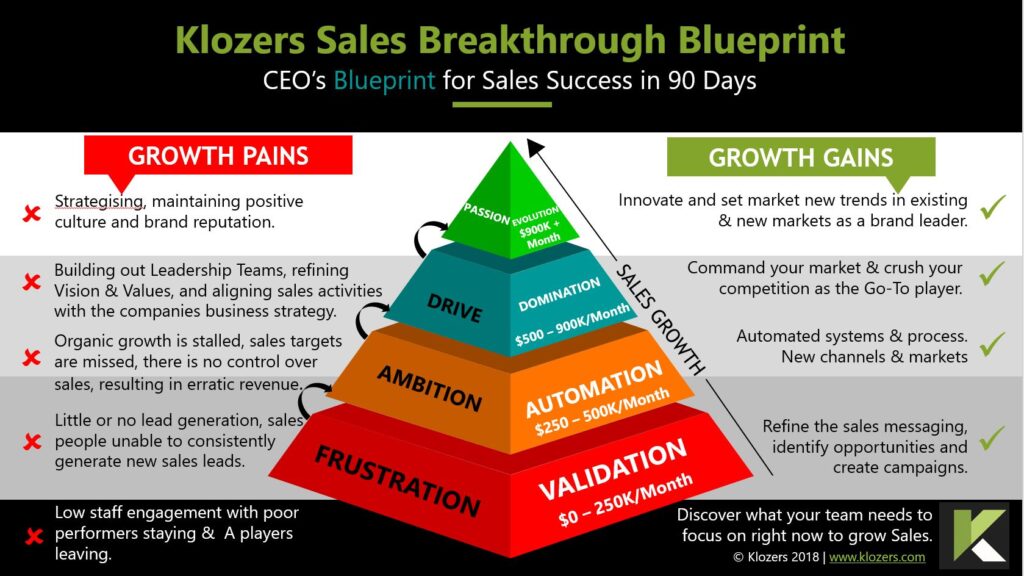
How to Sell to Big Companies. In order to sell to big companies you need to first create a shortlist of targets that meet your perfect prospect profile. Next, focus all your sales and marketing resources to research and create a unique sales approach for multiple contacts within the big company you are selling to.
What’s Inside
SESSION 1
The WHO
Introduction to Enterprise Selling
Selecting the right targets
Segmenting your accounts
Mastering the complex sale
Prep for Session 2
Get this session FREE
SESSION 2
The WHAT
The Door Opener
Right content, right contact, right time
How to write persuasive copy
The cadence of big account selling
The profitable, easy to deliver and replicate offer
SESSION 3
The HOW
What to say to Big Companies
How to control the sales conversation
The Contact Plan
Listen & Learn LIVE over the coaches shoulder
Your personal Action Plan
Course Author

Iain Swanston
Founder, Klozers
After 35 years in B2B sales Iain just loves solving sales problems.
If you’ve ever attended one of his live events you’ll know, even during the breaks and after the event he always likes talking about sales. Iain is an Author, Speaker & our Lead Sales Coach.
Iain is on a mission to make sales easier for B2B companies and their salespeople.
“In the short time I’ve been working with Klozers I’ve used his guidance to develop positive new sales activities, techniques and a mindset that has significantly helped my sales confidence. As a results I’ve already seen excellent performance benefits that are directly attributable to working to the coaching.”
Alan Wood
Scotland Director
Salesforce Marketing Cloud
“This was my first ever sales training and genuinely still the most pertinent in my sales career. Iain taught us how to take leads through the sales journey from lead to opportunity to closure, I still use these skills today and encourage my colleagues to do the same. My earnings have more than doubled since Iain gave that pertinent training and his latest blogs have been shared internally between our sales and marketing teams as the advice rings true to what we are currently working on as a department”
Lynne Hall
Strategic Accounts Manager
E-On Energy
“My coach was really flexible and was happy to talk in between my scheduled coaching slots, especially when I had burning questions and needed support fast. The debriefing calls we had after my sales meetings not only helped me understand where I could improve, they also gave me the right words to say, in the right sequence and at the right time.“
Elliott Boll
Enterprise Learning Consultant
Docebo
Get started now and get
your first session FREE
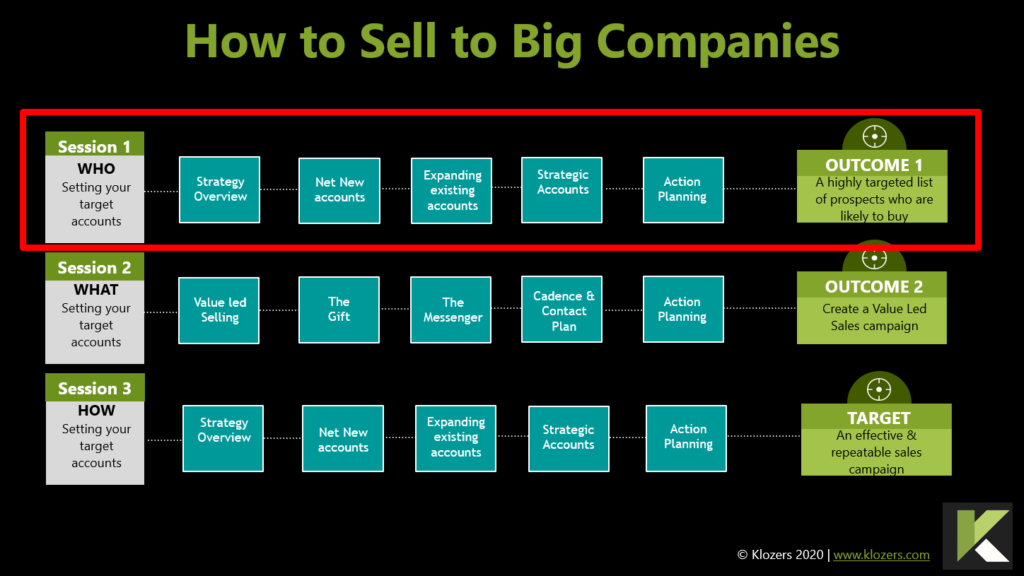
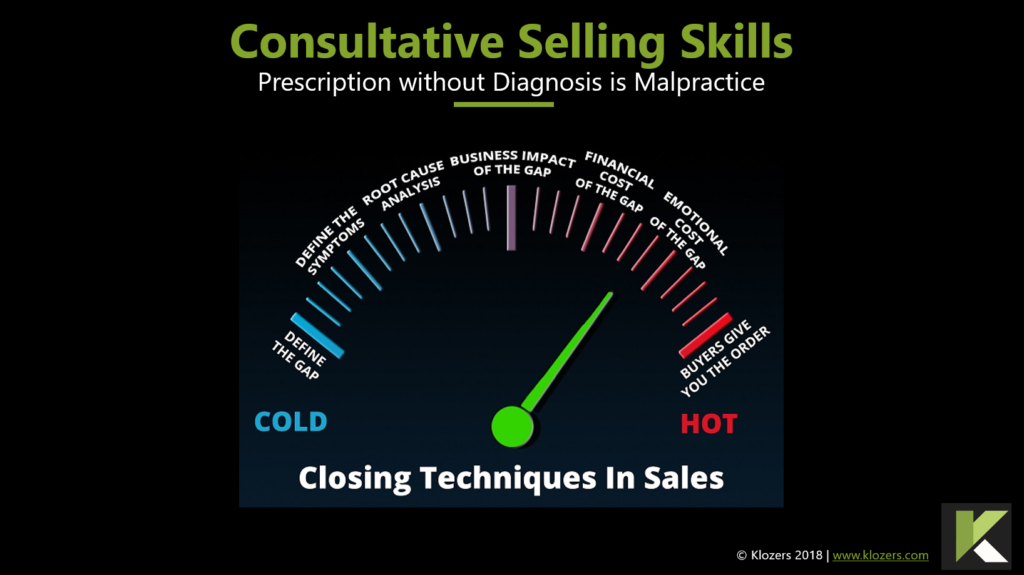
Get all the templates
you need to sell more now
Register here
Get the coaching you want, when you want it, at your desktop

“The first session was full of useful and practical sales information. I took so many notes and have come away with exercises I will carry out to help further clarify our approach to sales. I would highly recommend”
Rebecca Pick
Founder
Pick Protection
“Great training session with so much information packed into an hour. Looking forward to completing sessions 2 and 3. “
Max Anderson
Director
SuperBot Experts
Very insightful content from Klozers this afternoon. Thank you Iain Swanston for the invite to attend. This shall be hugely beneficial for our business moving forward and I am looking forward to putting my learning into practice
Laurie Wilson
Regional Sales Manager
CMP Products
Learn How to Sell to Big Companies
If you are new to sales at some stage you will want to learn how to sell to big companies. It’s common for most ambitious sales people and businesses, yet this can be a challenging or even, a near impossible experience.
For example, finding the right people to talk with (yes there will also be more than one decision maker) can be like finding the proverbial needle in a haystack, and then trying to coordinate all these decision makers can be like herding cats.
The longer sales cycles that inevitably arise from having multiple decision makers in a complex sale, then frustrate most sales people as time drags on.
The large revenues that Enterprise sales can deliver, more often than not, prove so elusive that the salespeople give up and focus on smaller opportunities, they know they can convert.
However, in some circumstances it can take the same amount of sales resources to convert a small opportunity as it does when selling the same product or service to a big company, so don’t give up just yet.
Learn More, Sell More, Earn More

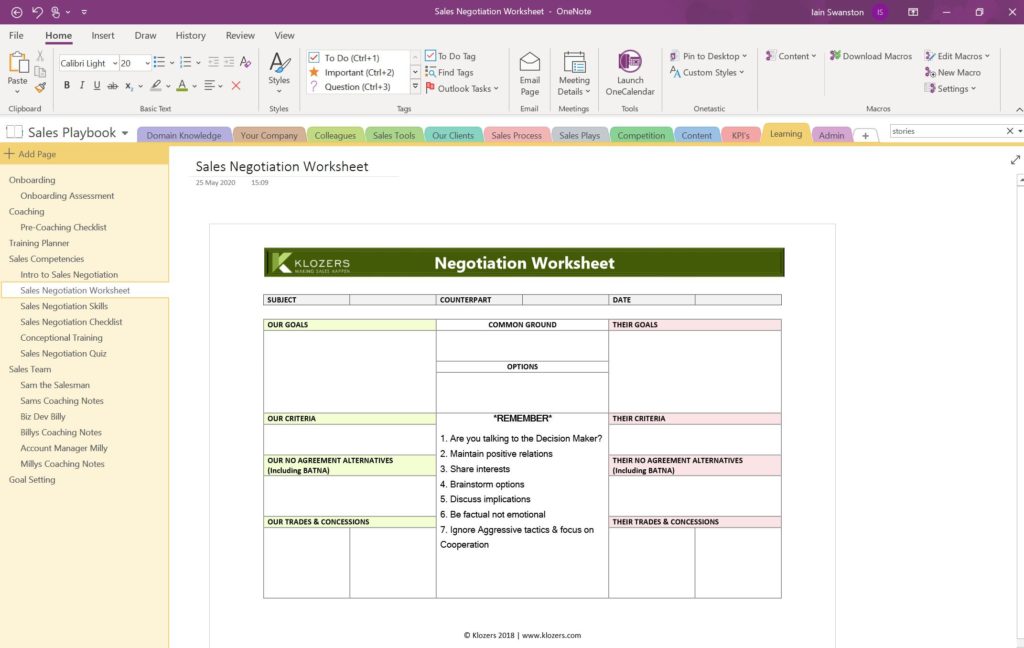
How to Sell an Idea to a Big Company
Maybe you don’t have a product or service but instead you have an idea that you want to sell. It’s the sames process and the fact is, it is possible to sell to big companies and large enterprise organisations, although it does need a slightly different approach.
The first FREE 60 minute session in this course walks you through the preparation and planning required before you approach big companies.
When you sell to big companies you may also need some additional sales resources that are not as commonly used when selling to smaller organisations, such as a Business Case, a Cost Benefit Analysis – don’t worry we’ve got templates you can use for all of these.
If this sounds like lots of work, then Yes it is, and because of this many companies will not rely on any one individual, instead they will work as a team to win large accounts. Part of that team should include Marketing in order that you can target the right people in the buying organisation, with the right messaging, at the right time.
Run the sales campaign as a mini project with scope, roles and responsibilities, costings, objectives and milestones. Needless to say that it usually makes sense to be targeting more than one big company if you are going to do this professionally, but don’t make the mistake of having too many, as the campaign can then turn into a marketing initiative which by their very nature are more generic.
The key to success is that all the messaging must be bespoke and relevant to every target which takes time, which is time that you won’t have if you have too many targets. Again this course covers everything you need.
Before you start selling to big companies there are however two important considerations you should address as follows:
1) Does your company have the capability to successfully deliver a project on the scale that a big company will require?
In most cases you will only get one chance to sell to a big company and delivering success for your first big company will also give you a reference point that will help you sell to other big companies.
2) Does your company have the financial resources required to sell to a big company?
If you buy materials in January to create stock for February and have agreed 90 day payment terms this means you have to run 150 days without being paid. Some small businesses are not sufficiently funded to do this, so be careful what you wish for.
Selling to big companies can transform your business, but like most things in life that are worthwhile it’s usually not easy and doesn’t happen overnight, but it certainly can be worth it.
Get started now and get
your first session FREE






